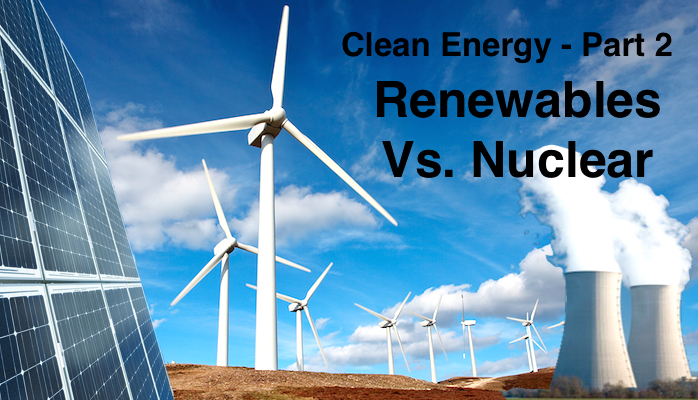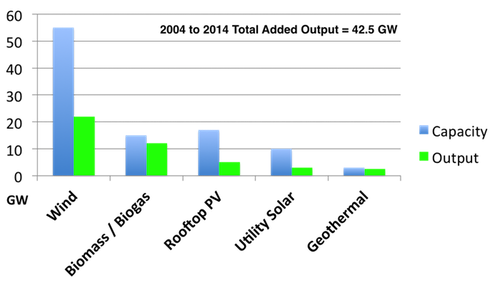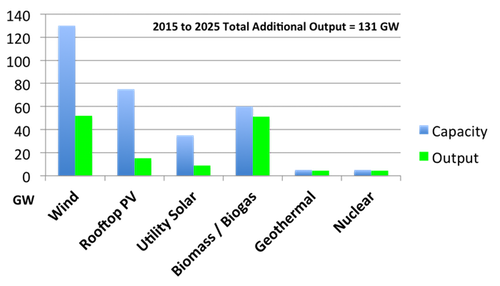Green Energy
- The Growing Economic Case For Renewable Energy
By Nick Lawton, Policy AnalystThe economic case for renewables continues to become stronger. Solar and wind energy facilities are simultaneously becoming more efficient and less costly. Today, in terms of levelized cost of energy...
- A Call For Strong, Stable Renewable Energy Policy In The United States
By Nick Lawton, Policy AnalystThe International Energy Agency (IEA) recently released itsRenewable Energy Medium-Term Market Report 2014, revealing that although 2013 witnessed the fastest expansion of renewable energy capacity to date, the IEA expects...
- Withdrawal Of Assembly Bill 177 Threatens California’s Renewable Energy Leadership
By Nick Lawton California has long been a leader in renewable energy policy, but the withdrawal of Assembly Bill 177 threatens the state’s leadership by failing to strengthen its renewable portfolio standard (RPS). California was among the first states...
- Japan On The Road Of Renewable Energies
Article published on www.bloomberg.com/news on March, 15th 2013By Chisaki Watanabe Japan Adds 1,178 Megawatts of Mostly Solar Energy in Nine Months Japan added 1,178 megawatts of mostly solar clean-energy capacity in the nine months...
- Bnef: Pv Will Be Cheaper Than Fossil Fuels In Australia By 2020
Article published on www.pv-magazine.com on February, 8th 2013 Bloomberg New Energy Finance (BNEF) forecasts that large-scale photovoltaic systems will supply energy cheaper than coal and gas by 2020 in Australia. Already, it states, wind farms...
Green Energy
Renewables vs. Nuclear: Do We Need More Nuclear Power?
Article originally published in www.renewableenergyworld.com, on april 29th, 2015.



The above output numbers for renewables assume no advances in wind or solar efficiency and no grid storage. Both assumptions will become completely false, so the 131 GW number should be considered a minimum number. Capacity factor numbers used were 40 percent wind, 25 percent utility solar, 20 percent rooftop PV, 85 percent biomass/biogas, 80 percent geothermal. Note that some of the utility solar added to the grid was solar thermal with molten storage, with an 80 percent capacity factor, so 25 percent capacity factor number was used to encompass all utility solar. Obviously, we can not use EIA’s capacity factor numbers for renewables, as they only have renewable generation data for the last four months of 2014. That means no summer months for solar and a few missed windy months for wind.

For at least the next 10 years, when considering new capacity, there should be little doubt that renewables will be the generation method of choice. Utility PV, solar thermal (especially with molten salt storage as a baseload source), wind, rooftop solar and biomass will be the highlights, along with contributions from biogas (sewage, landfills and livestock), geothermal, and maybe even some waveand tidal. Advances in storage technologies and reductions in price will help remove the intermittency concerns of some renewables. The next ten years should be another decade of rapid growth.
When considering a transition from the dirtiest of fossil fuels, nuclear is also a possibility, and therefore, nuclear will be discussed along with renewables. Nuclear’s time to build, risk, waste and especially costs will be scrutinized, as the costs for nuclear are rising while renewable costs are decreasing.
Cities and nations are rapidly installing small and large-scale renewable power sources and new storage technologies. Even China, currently the most aggressive country with respect to nuclear power, is adding more capacity with wind and solar compared to nuclear — and it’s not just nameplate capacity — it’s actual generated power. Last year alone, China added 20.72 GW of wind (4.8 GW output as their capacity factor is only 23 percent) and 28 GW of solar (10.6 GW output), with around 90 percent of their solar installations coming from utilities. New capacity from wind and solar were more than the 5 nuclear plants added in the same year (5.7 GW output). China is just one example of how wind and solar can be built faster while generating more power. By the time (and if) China completes their 28 nuclear plants (many are already behind schedule), with an added capacity of 34 GW, they will have added more power from wind and solar in the same timeframe — again, taking capacity factors into account.
In the next 10 years, here in the U.S., our five nuclear plants are many years behind schedule and are billions of dollars over budget. When they come online, they will generate 5.1 GW while renewables will generate a very conservative 131 GW.
Let’s take a look at the last 10 years and the next 10 years…
New U.S. renewable and nuclear capacity added the last 10 years (output):
- 55 GW utility wind (22 GW)
- 17 GW rooftop PV solar (3.5 GW)
- 10 GW utility PV and solar thermal (2.5 GW)
- 15 GW biomass and biogas (12 GW)
- 3 GW Geothermal (2.5)
Total renewables: 100 GW (42.5 GW)
Total nuclear: Marginal increase from existing plants
Total nuclear: Marginal increase from existing plants

In the last 10 years, renewables added around 40 nuclear reactors-worth of electricity.
U.S. renewable and nuclear plan the next 10 years capacity and (output):
- 130 GW utility wind (52 GW)
- 75 GW rooftop PV solar (15 GW)
- 35 GW utility PV and thermal solar (9 GW)
- 60 GW biomass and biogas (51 GW)
- 5 GW Geothermal (4 GW)
Additional renewable power next 10 years: 305 GW (131 GW)
Additional nuclear power next 10 years: 5.6 GW (5.1 GW)
Additional nuclear power next 10 years: 5.6 GW (5.1 GW)

In the next 10 years, renewables will add well over 100 nuclear reactors-worth of electricity.
The above output numbers for renewables assume no advances in wind or solar efficiency and no grid storage. Both assumptions will become completely false, so the 131 GW number should be considered a minimum number. Capacity factor numbers used were 40 percent wind, 25 percent utility solar, 20 percent rooftop PV, 85 percent biomass/biogas, 80 percent geothermal. Note that some of the utility solar added to the grid was solar thermal with molten storage, with an 80 percent capacity factor, so 25 percent capacity factor number was used to encompass all utility solar. Obviously, we can not use EIA’s capacity factor numbers for renewables, as they only have renewable generation data for the last four months of 2014. That means no summer months for solar and a few missed windy months for wind.
The additional nuclear power output of 5.1 GW will come from 5 under construction plants that are behind schedule and billions over budget. They include Watts Bar, Summer and Vogtle. Even favorable policies and new plant approvals won’t change nuclear’s contribution — nuclear is expensive and takes too long to build. The next 10 years = five reactors = 5.1 GW output.
The 10 year projection for renewables is highly conservative. We excluded EIA’s projections due to flawed data (more on that here, here and here), but I’ve considered Exxon’s really low projections and ACORE’s really high projections. The estimate of 131 GW for renewable generation is about half of the optimistic generation estimate of 254 GW, although even that estimate is obtainable with favorable policies.
So, here is the big question: why are renewables growing faster than nuclear, even in places like China where they are building the most reactors? In places like the U.S., Japan and Europe, is it because of nutty environmentalists and anti nuclear groups? Isn’t that what happened with Vermont Yankee? Actually, no - Vermont Yankee really closed because the O&M costs became too high. The real answers: risk, cost and time to build.
Nuclear Takes Longer to Build and Costs More than Renewables
Nuclear plants today are far more complex than the ones built decades ago. The AP1000 is a new reactor, and both China and the U.S. are behind schedule with their reactors. Here in the U.S., take Vogtle for example. Vogtle is now running three years behind schedule — and over $2 billion USD over budget. The revised expected price tag for the two reactors is now around $15 billion USD, and rising. These delays and budget overruns so far have cost Georgia ratepayers an extra $14 per monthon their electric bill. When finished, Vogtle's two reactors will generate wholesale power at rates around $120 per MWh — that’s $0.12/kWh which is the current national average RETAIL rate. The other three reactors will have generation rates at least $108 per MWh, equivalent to $0.108 per kWh. So, the next time you hear Ted Cruz or the Koch brothers talk about how renewables are going to raise utility bills, remember, reality proves otherwise.
When considering Levelized Cost of Energy (LCOE), nuclear decommissioning costs are excluded from the calculation. This is a big deal, because recent decommissioning costs have been running between $1 billion USD (Vermont Yankee) and $4 billion USD (San Onofre). Then, there are ongoing costs, as nuclear waste remains on-site and must be guarded and secured. While ratepayers pay a fee to cover the decommissioning costs, the fees collected were based upon old cost estimates. $900 million in subsidies have already been provided for decommissioning costs (more on that here), and this figure is expected to rise as current deficits are in the tens of billions of dollars range (more on that here).
Also not included: potential cleanup costs from a nuclear incident. Japan’s government has already spent over $100 billion USD on cleanup efforts related to Fukushima, and it’s projected the cost will exceed $300 billion USD. Bottom line is that even without cleanup costs, wind, solar and other renewables are less expensive to build and electric rates are less expensive than nuclear. More on LCOE can be found here. Remember, nuclear decommissioning costs are NOT included, even though those costs are eminent.
Speaking of subsidies, are you tired of hearing how renewables are highly subsidized compared to fossil fuels and nuclear? Anyone that makes this statement is either lying or they simply have not done their homework. When considering lifetime subsidies, the oil, coal, gas and nuclear industries have received approximately $630 billion in U.S. government subsidies. Wind, solar, biofuels and other renewable sectors have received a total of roughly $50 billion in government investments. Also, oil and gas subsidies were five times greater than renewables during the first 15 years of each subsidy’s life and more than 10 times greater for nuclear. Furthermore, consider that non-renewable subsidies are guaranteed to renew, offering those industries decision-making security, while renewable subsidies have been uncertain. How fair is that? You can find more info on subsidies here and here.
Who makes the decision whether to build nuclear or renewables? Is it the pro nuclear or pro renewable camps? No, it’s the utilities and consumers, and they are the ones choosing renewables.Utilities are purchasing wholesale power cheaper from renewables than from coal, nuclear and sometimes even cheaper than from gas. Hydro has always been cheap, but consider wind and solar. Utilities are securing PPAs from wind and solar at rates in the 2.5 to 5 cent/kWh range for wind, and 5 to 9 cent/kWh range for solar. For example, the 50 MW Macho Springs solar plant in New Mexico delivers power for 5 cents/kWh under their PPA. That is especially low, but most U.S. solar projects in the U.S. have PPAs in the 6 to 8 cent/kWh range. Even if you take out the PTC from wind in Texas, a utility would still be buying power under 5 cents/kWh. Furthermore, prices for wind and solar continue to drop rapidly. More info on recent PPAs here.
Do we need nuclear as a baseload source of energy?
If we are to transition from fossil fuels, it’s important to note that during this transition, existing nuclear power plants are needed. Nuclear provides 19% of our baseload electricity. The nuclear plants in operation today have already been built, and decommissioning costs are eminent, no matter when they close. Provided they continue to operate safely, they will continue to help offset fossil fuel use. With plant extension plans, many plants can operate for another 30 or more years.
What about renewable’s intermittency and dispatchability? First, consider the fact that not all renewables are intermittent. While the U.S. does not intend to add much more hydro, it is an existing source of baseload energy, currently generating 6% of our needs. Solar thermal with molten storage, biogas, biomass (especially cleaner electro and biochemical biomass) and geothermal all provide baseload sources of energy.
Wind and solar become highly dispatchable with storage. Fortunately, storage prices are dropping rapidly. Vanadium flow batteries are already viable options. LI-ion batteries are running at more than 90 percent efficiency. Tesla’s gigafactory is expected to cut costs 30 percent by 2020, and $100/kWh prices are expected within the next 10 years — perhaps sooner. There’s a startup company called Sakti3that developed a less expensive solid state LI-ion battery — and they start manufacturing this year. Additional options included various methods utilizing hydrogen. All are technically and economically realistic.
It’s usually those in the pro nuclear or fossil fuel camps that cite intermittency as the key issue with renewables. I find it ironic, that those who have even a fundamental understanding of nuclear, can’t seem to find answers to relatively simple problems. Compare and contrast the difficulties of fission, handling nuclear waste, building dozens of nuclear plants simultaneously, along with the costs — to solving intermittency. In other words, humans can construct highly complex reactors, prepare fuel, split atoms and manage radioactive waste, all of which require immense short and long-term financial investments, yet we can not utilize various storage techniques, generation diversity and a smarter grid?Obviously, we can, and we will.
Decarbonization: Risk Versus Reward
Why not build nuclear AND renewables? The fact that renewable generation is outpacing nuclear in China is significant because China is currently the most aggressive with their nuclear ambitions — yet, they are building renewables even faster. This raises a question: what if China used the labor, resources and money towards an all-renewable approach? Yes, nuclear and renewables can be built together to help with decarbonization, but, a renewables only approach can also work, technically and economically. Could an all renewables solution be a better approach to decarbonization? Is it technically possible?
Economics, both from the perspectives of the utilities and consumers, are really driving the push for renewables over nuclear. In addition to the points above, consider Areva’s financials (along with their statements), their push into renewables and also Siemens exit from the nuclear industry. On the utilities side, they are the ones that ultimately decide how to procure power, and they are the ones that are choosing renewables. Even in Texas, the land of Ted Cruz, places like Georgetown are now 100 percent powered by wind and solar.
The other key factors boil down to safety and security. When things go wrong at a nuclear plant, due to accidents, terrorists or nature, they can go very wrong. The damage can cripple or destroy a city and even a Nation. Is it likely? Who really knows for sure. Can you predict the next earthquake in Southern California — or anywhere in the U.S. or Japan or the rest of the world? What about the nexttsunami wiping out a coastline? What about the next cyberattack or terrorist organization in the Middle East? Compare a catastrophe with a nuclear plant to that of a solar or wind farm. When you ask me why I am against building new reactors, it’s a matter of economics, safety and security, and the fact that we CAN build upon existing hydro and nuclear with all renewables - and we can do it faster.
- The Growing Economic Case For Renewable Energy
By Nick Lawton, Policy AnalystThe economic case for renewables continues to become stronger. Solar and wind energy facilities are simultaneously becoming more efficient and less costly. Today, in terms of levelized cost of energy...
- A Call For Strong, Stable Renewable Energy Policy In The United States
By Nick Lawton, Policy AnalystThe International Energy Agency (IEA) recently released itsRenewable Energy Medium-Term Market Report 2014, revealing that although 2013 witnessed the fastest expansion of renewable energy capacity to date, the IEA expects...
- Withdrawal Of Assembly Bill 177 Threatens California’s Renewable Energy Leadership
By Nick Lawton California has long been a leader in renewable energy policy, but the withdrawal of Assembly Bill 177 threatens the state’s leadership by failing to strengthen its renewable portfolio standard (RPS). California was among the first states...
- Japan On The Road Of Renewable Energies
Article published on www.bloomberg.com/news on March, 15th 2013By Chisaki Watanabe Japan Adds 1,178 Megawatts of Mostly Solar Energy in Nine Months Japan added 1,178 megawatts of mostly solar clean-energy capacity in the nine months...
- Bnef: Pv Will Be Cheaper Than Fossil Fuels In Australia By 2020
Article published on www.pv-magazine.com on February, 8th 2013 Bloomberg New Energy Finance (BNEF) forecasts that large-scale photovoltaic systems will supply energy cheaper than coal and gas by 2020 in Australia. Already, it states, wind farms...
